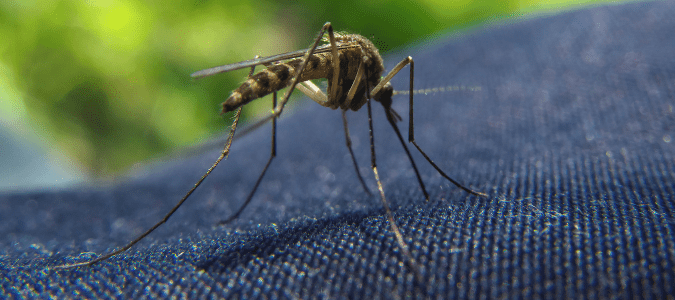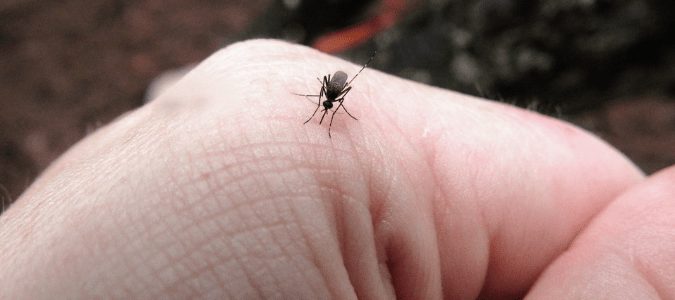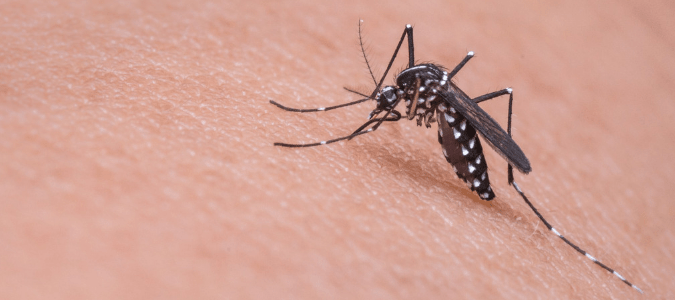How long do most mosquitoes live? Understanding the lifespan of common mosquito species can help you better control mosquitoes around your property. To understand the mosquito lifespan, you need to learn about their life cycle and the phases they go through.
Next, there are key differences between female versus male mosquitoes. Understanding how each sex looks and behaves can help homeowners keep them at bay.
Finally, mosquito bites are uncomfortable, and everyone reacts to them differently. Keep reading to learn how to treat a common mosquito bite.
What is the Life Span of a Mosquito?
Two of the most common species of mosquitoes are the Aedes and the Anopheles mosquitoes. It’s important for homeowners to understand the life span of both species since they are most likely to encounter these pests.
The best way to treat a mosquito problem is to control them at all stages of their life cycles, from egg to adult. Keep reading to learn more about the life cycles of both Aedes and Anopheles mosquitoes.
Aedes Mosquito Life Span
Like other mosquito species, the Aedes mosquitoes start their life cycle as eggs. Female Aedes mosquitoes lay their eggs in water; however, they can survive for several months in dry conditions. The eggs are often laid on the inner walls of water containers, such as inside buckets, barrels and pet water bowls.
The eggs sit just above the water line until they hatch, and a female Aedes mosquito can lay up to 100 eggs at a time. If the conditions are too dry, the eggs wait until the environment is wet enough to hatch, and then they emerge from the eggs as larvae. Often, rainfall or humans adding water to the container can cause the mosquito eggs to hatch.
In the larval stage, Aedes mosquitoes live underwater and feed on organic matter nonstop. This stage typically lasts between 5 and 14 days. The Aedes larvae molt three times in this stage, getting bigger each time. Finally, the larvae molt into the pupal stage.
Aedes mosquito pupae live in water and rest as they transition into adult mosquitoes. They do not feed during this time. After one to four days, the adult mosquito emerges from the pupa skin and flies away.
The adult stage is the last phase of the Aedes mosquito life cycle. They can live indoors and outdoors and typically live for a few weeks to a few months. Adult mosquitoes mate during that time, and the females lay eggs to start the life cycle over again.
Anopheles Mosquito Life Span
Like the Aedes mosquitoes, Anopheles start their life cycle as eggs. However, female Anopheles mosquitoes typically lay their eggs in freshwater sources like ponds, lakes and rivers. They only remain as eggs for two to three days before they hatch.
Once the Anopheles eggs hatch, they enter the larval stage. Anopheles larvae molt four times over seven to ten days. Like Aedes, they feed on organic matter the entire time during the larval stage.
Next, Anopheles mosquitoes enter the pupal stage, which only lasts for one to two days. During this phase, the mosquitoes undergo intense internal changes to emerge as adult Anopheles mosquitoes.
Adult Anopheles live for a few days to a few weeks; however, environmental factors play a big role in how long they live and how quickly they go through each life cycle phase. For example, heat tends to accelerate the mosquito life cycle, which leads to more breeding and larger populations.
Control Mosquitoes at All Stages of the Life Cycle
Most at-home mosquito solutions only slightly reduce the adult population. However, the most effective way to control mosquitoes on your property is to treat them at every phase of their life cycle. Professional pest control services have the tools and treatments needed to control mosquitoes at every phase, especially when they are in the earlier phases and hard for homeowners to see.
Female Versus Male Mosquito
Most homeowners can’t tell the difference between female versus male mosquitoes; however, there are key differences in their appearance and behavior that can help distinguish them.
For example, female mosquitoes are typically larger than male mosquitoes, and they have a more robust look overall. Males are known for their smaller size and delicate body structure.
Females are also known for being darker in color and having interesting patterns on their bodies and wings. Males, on the other hand, are lighter and look more uniform because they usually don’t have patterns on their bodies.
You can also tell female and male mosquitoes apart by their antenna. Female mosquito antennae are thread-like and hard to see because they are only used for detecting hosts for their blood meal and sensing body heat. Male mosquito antennas are bushy and feathery because they are used to detect sounds and identify mates.
When it comes to their behavior, female and male mosquitoes behave extremely differently. Female mosquitoes require blood in order to nourish their eggs. Because of this, they bite humans. Male mosquitoes, on the other hand, do not bite.
Mosquitoes can carry various diseases, which is why it’s important to control mosquito infestations. The best way to control these unwanted pests is to utilize professional pest control services. An expert will treat the problem for you and teach you how to deter mosquitoes so that you can enjoy your home again.
How Long Does a Mosquito Bite Last?
Mosquito bites can sometimes be painful and uncomfortable, and many people want to know how long a mosquito bite lasts before they experience relief. However, it’s important to remember that different people have various reactions to mosquito bites.
However, most mosquito bites result in a red bump that peaks around 24 to 36 hours after the bite occurs. In addition, the location of the bite usually itches for three to four days. Some people do not even notice when they have a mosquito bite because the symptoms are extremely mild. Unfortunately, others experience intense symptoms.
Typical mosquito bite symptoms include itching, swelling and redness. The symptoms usually increase and get worse as the red bump peaks.
After a few days, the itching and other symptoms should disappear, and the red bump should fade. To treat a mosquito bite, apply a cold compress to the site to reduce swelling and redness. Keep the compress on the bite for 10 to 15 minutes. Try not to itch it, as that will only aggravate it more.
However, some people will need to contact a healthcare professional to treat their mosquito bites. For example, if you experience an extreme reaction to a bite beyond the usual mill symptoms, contact your doctor.
While rare, severe allergic reactions to mosquito bites manifest as significant swelling, blistering and hives that spread beyond the site of the bite. Mosquito bites can also become infected. They will appear redder and swollen and may produce puff.
To limit mosquito bites, contact a professional pest control service to get rid of mosquitoes. Controlling the population is the best way to reduce the chance of mosquito bites.
The Bottom Line
Mosquitoes are pesky insects that can get in the way of summer fun. However, learning about their life span can help homeowners control them. Learning about the differences between female versus male mosquitoes and how to treat mosquito bites can make these pests seem less threatening.
Mosquito problems on your property can make it uncomfortable to spend time outside. Trust a pest control professional to control the population at every phase of their life span.
ABC Can Reduce Mosquito Populations on Your Property
If you’re ready for relief from mosquitoes, contact ABC Home & Commercial Services. Our pest control professionals will create a customized mosquito control plan. This way, you and your family members can feel more at ease in your outside space again.


